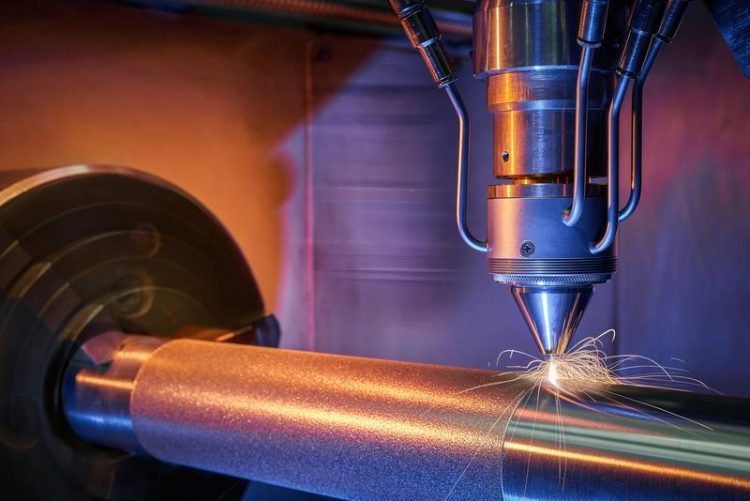Corrosion and Wear Protection: Economical, Environmentally Friendly and Extremely Fast

With EHLA, metal protective layers can be applied with ultra-high-speed. Fraunhofer ILT, Aachen, Germany / Volker Lannert.
Protecting components against corrosion and wear is no simple matter. Standard processes such as hard chrome plating, thermal spraying and deposition welding have drawbacks. Up to now, laser material deposition has been used only in specific applications. With ultra-high-speed laser material deposition, or EHLA, researchers at Fraunhofer ILT in Aachen and RWTH Aachen University have developed and patented an alternative process to overcome shortcomings of the conventional processes in the areas of coating technology and repair.
“We can now use EHLA to apply thin layers in the range of a tenth of a millimeter over large surfaces within a short time, while being resource-efficient and economical,” Dr. Andres Gasser, group manager at Fraunhofer ILT, summarizes.
An Alternative to Hard Chrome Plating
One of the most common processes for the application of corrosion and wear protective coatings is hard chrome plating. However, this consumes a lot of energy. In addition, chromium(VI) harms the environment – which is why, from September 2017, it can only be used with specific authorization. EHLA now offers companies an economical alternative.
Its chemical-free application makes the process very environmentally friendly. The resulting layer is metallurgically bonded to the base material and, unlike hard chrome layers, does not delaminate. While hard chrome plating layers have pores and cracks, layers produced using EHLA are non-porous and, thus, offer more efficient long-term protection.
More Efficient Use of Resources than Thermal Spraying
Thermal spraying, too, has disadvantages. This process consumes a lot of material and gas because only about half of the material used ends up coating the component surface. In addition, the resulting layers bond only weakly to the substrate. Due to their porosity, it is necessary to apply several layers, each roughly 25 to 50 micrometers thick, on top of each other.
In comparison, the new EHLA process uses about 90 percent of the material, making it far more resource efficient and economical. Not only are the individual layers non-porous, they also bond firmly to the substrate.
Faster and More Broadly Applicable than Deposition Welding Processes
Deposition welding processes are used to produce high-quality and firmly bonded coatings. With conventional processes such as tungsten inert gas (TIG) welding or plasma powder deposition, however, the layers of 2 to 3 mm are often far too thick and, as a result, too much material is used. Laser material deposition already allows for far thinner layers – between 0.5 and 1 millimeter, but is too slow for large components, which is why it has only been used for specific applications so far.
A further drawback of the process is that it requires a certain melt pool size in order to create a defect-free layer: the component is locally melted, while a powder nozzle directs a powdery additive into the melt pool. Dr. Gasser explains the key element of the new process: “With EHLA, the laser melts the powder particles while they are above the melt pool.” Since this means that drops of liquid material fall into the weld pool instead of solid powder particles, the layer becomes more homogenous. In addition, less base material needs to be melted: instead of up to a millimeter, now only a few micrometers suffice.
As a result, the component can be coated 100 to 250 times faster than with conventional laser material deposition, with minimal heating of the substrate. Thus, EHLA facilitates the coating of heat-sensitive components, which was impossible due to excessively high heat input up to now. Also, the new process can be used for completely new material combinations such as coatings on aluminum base alloy or cast iron.
In close cooperation with ACunity GmbH from Aachen, Germany, which is a spin-off of the Fraunhofer ILT, the Dutch company Hornet Laser Cladding B.V. will deliver the first EHLA system to China in the near future. It shall be used for research purposes and industrial applications at the Advanced Manufacture Technology Center of China Academy of Machinery Science & Technology CAMTC in Beijing.
At this year’s LASER World of PHOTONICS from June 26 to 29 in Munich, Germany, our experts will be presenting the EHLA process (stand A2.431).
Honored with the Joseph von Fraunhofer Prize 2017
At the Fraunhofer General Assembly Meeting, held on May 30 in Dresden, Germany, Dr. Andres Gasser, Thomas Schopphoven and Gerhard Maria Backes received the Joseph von Fraunhofer prize, which carries a reward of 50,000 euros, in recognition of their work.
Contact
Dipl.-Ing. Thomas Schopphoven
Laser Material Deposition Group
Fraunhofer Institute for Laser Technology ILT, Aachen, Germany
Telephone +49 241 8906-8107
thomas.schopphoven@ilt.fraunhofer.de
Dr.-Ing. Andres Gasser
Group Manager Laser Material Deposition
Fraunhofer Institute for Laser Technology ILT, Aachen, Germany
Telephone +49 241 8906-209
andres.gasser@ilt.fraunhofer.de
Dipl.-Ing. Gerhard Backes
Chair for Digital Additive Production DAP
RWTH Aachen University, Aachen, Germany
Telephone +49 241 8906-410
gerhard.backes@ilt.fraunhofer.de
Media Contact
All latest news from the category: Materials Sciences
Materials management deals with the research, development, manufacturing and processing of raw and industrial materials. Key aspects here are biological and medical issues, which play an increasingly important role in this field.
innovations-report offers in-depth articles related to the development and application of materials and the structure and properties of new materials.
Newest articles

NASA: Mystery of life’s handedness deepens
The mystery of why life uses molecules with specific orientations has deepened with a NASA-funded discovery that RNA — a key molecule thought to have potentially held the instructions for…

What are the effects of historic lithium mining on water quality?
Study reveals low levels of common contaminants but high levels of other elements in waters associated with an abandoned lithium mine. Lithium ore and mining waste from a historic lithium…

Quantum-inspired design boosts efficiency of heat-to-electricity conversion
Rice engineers take unconventional route to improving thermophotovoltaic systems. Researchers at Rice University have found a new way to improve a key element of thermophotovoltaic (TPV) systems, which convert heat…



